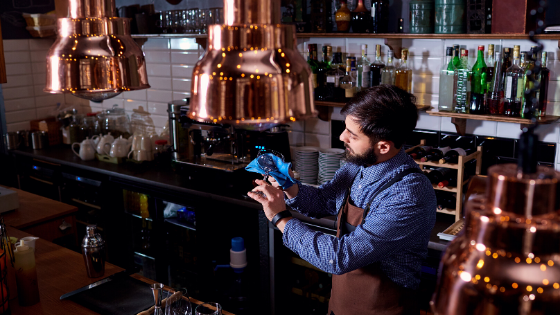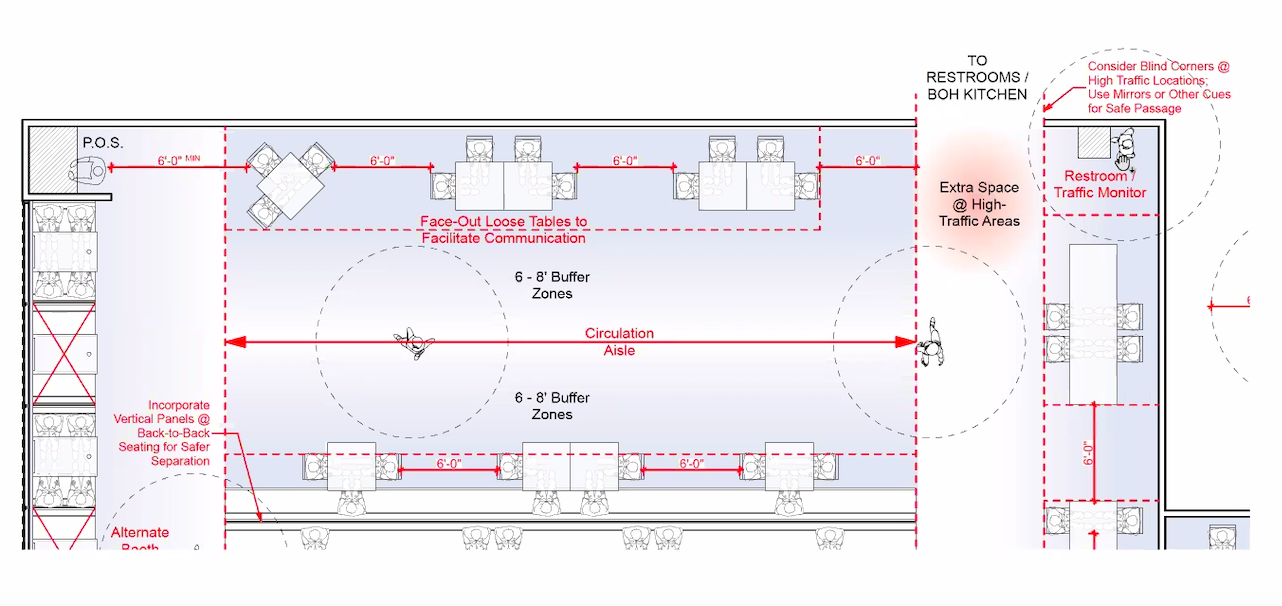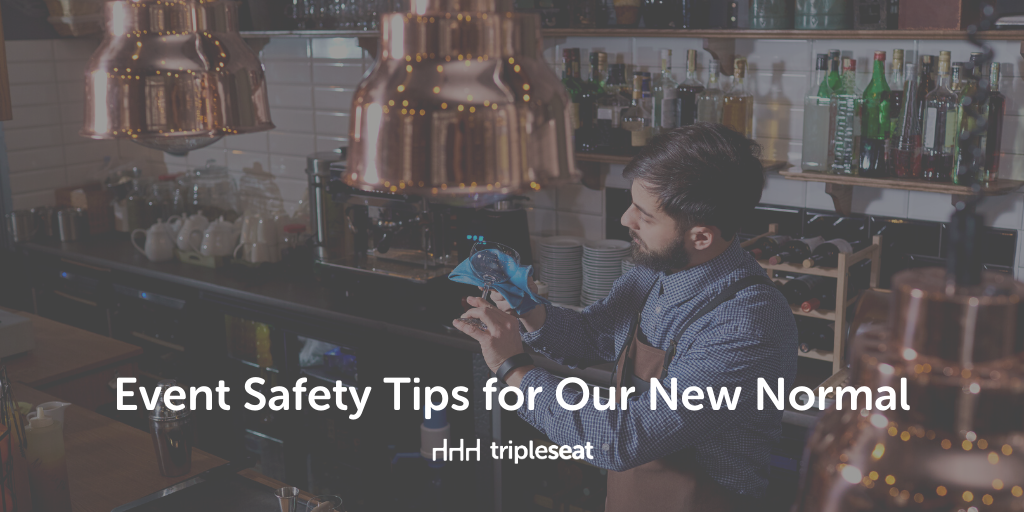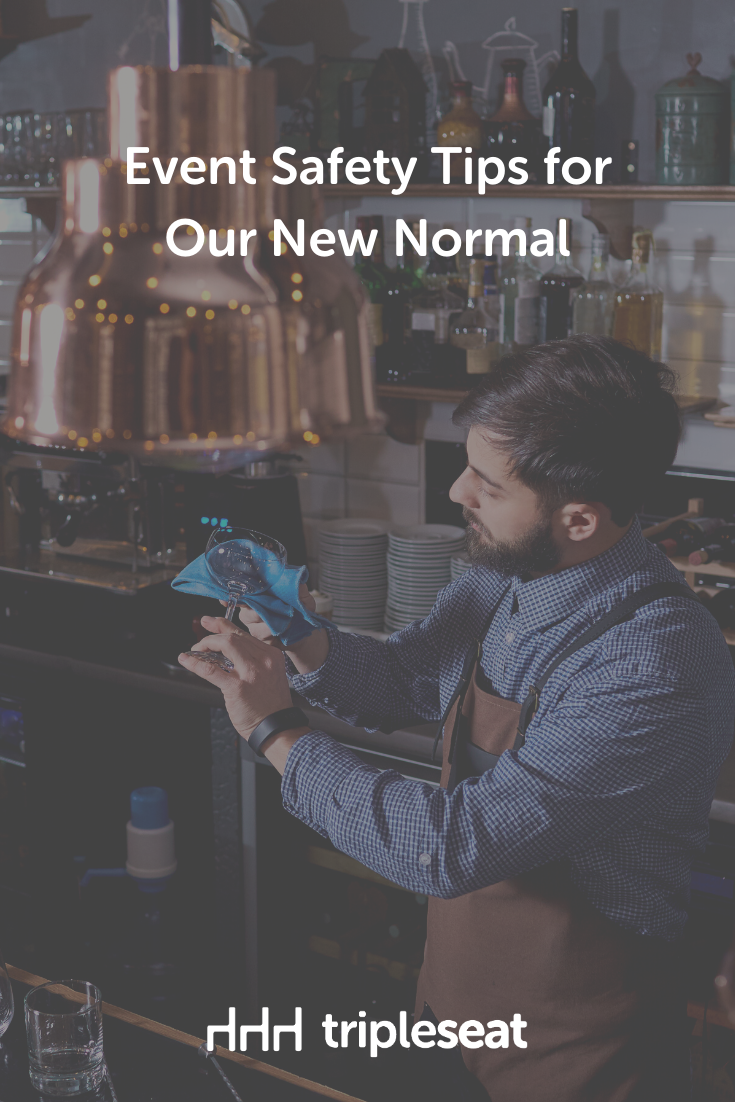Event Safety Tips for Our New Normal

As states closed restaurant dining rooms in March to help stop the spread of COVID-19, owners and operators went into survival mode. Some venues introduced takeout and delivery services for the first time, while others closed their doors completely and focused on different ways to support their staff. Now, as we enter May, many states have started to lift restrictions and allow dining rooms to reopen under strict guidelines.
Increased focus on food safety, sanitizing and cleaning practices, social distancing, and employee health monitoring and personal hygiene will all be a priority. Rules most likely will not be the same across all markets. But it’s safe to assume that best practices will be relatively universal. Here are some of those best practices and ways you can adjust your venue to adhere to them:
Disinfection protocols
Restaurants have always been held to a high standard of cleanliness, and that certainly has not changed. Your daily routine should involve a schedule of wiping down all highly touched surfaces including, but not limited to, POS systems, doorknobs and handles, railings, light switches, faucets, toilet levers, and chairs. You can also wipe down tables and condiments between each seating but remember to wash them after sanitizing them as they are considered food-contact surfaces. You should wipe down all of these surfaces before you open, and a minimum of every four hours after that until closing. Remember not to completely overlook seldom-touched surfaces. They don’t have to be wiped down every four hours, but they should not be forgotten altogether. Every restaurant should have an Environmental Protection Agency-registered disinfectant approved for use against COVID-19 on hand, you can find a list of them here. For information on Centers for Disease Control-approved methods of cleaning and disinfection, you can view their full list of guidelines here.
Cleaning restaurant equipment and tools
When it comes to foodservice equipment, the rule has always been to keep it clean. Make sure to change your fryer oil on a regular basis. Ensure your refrigerator and freezer storage units are working correctly and at the right temperatures. Label all storage items and make sure they are stored off of the floor. Check to make sure the dishwasher is working properly, and you have the correct detergent. These are all rules that owners and operators should already know and follow. I’m sure I am missing some, but you get the point. Just keep your kitchen and food service areas clean and safe. Remember to check the Food and Drug Administration’s food code for more vital food service safety information.
Social distancing measures
By now, we should all be aware that we need to keep a distance of six feet between ourselves and anyone else around us; this same rule must be applied to in-house dining. Freestanding tables should be set up no less than six feet from each other, and you may consider booth partitions or utilizing every other booth to ensure proper distance. Walkways should allow for people to move freely between tables at a distance of, you guessed it, no less than six feet.
To avoid large gatherings in waiting areas, offer to text customers when it’s their turn to sit down — this allows them to sit and wait safely in their cars. You may want to also consider designated entrances and exits so people aren’t running into each other as they enter and leave. Replace reusable menus and check presenters with technology solutions such as mobile ordering, QR codes, and contactless payment options. Remember, when you are rearranging your venue to fit within the guidelines, you must also take into consideration service areas and your staff. Consider relaying information to your workers through a mobile app or text instead of pre-shift meetings. Check out the diagram below of a great reopening seating strategy from CORE, an architecture and design firm in Washington, D.C.

Employee health and personal hygiene
Not only does this topic matter to your employees, but it also matters to your customers. They will want to be reassured that the people serving them and preparing their food are healthy. One thing that has not changed is the FDA guideline that employees who feel sick must stay home. What has changed is that when an employee stays home because of sickness, they should, at a minimum, self-quarantine themselves for seven days, and be symptom-free for three days thereafter without medication. Once those guidelines are met, they should follow the proper screening protocol to ensure they are safe to come back to work. Although the CDC has not mandated taking employees’ temperatures, you might want to implement the process at your venue. It doesn’t hurt and will give you even more reassurance that your staff is healthy.
Because, for obvious reasons, it’s difficult for servers to keep a distance of six feet from customers, you might consider making face masks mandatory if your state doesn’t mandate them already. It’s important to make sure your staff is educated on the proper way to wear and clean their mask. Some venues may also decide to have their staff wear protective gloves. Just remember that wearing gloves can give your staff a false sense of security. It’s recommended that they are only worn when preparing food and handling food that is ready to eat.
Instilling consumer confidence
I believe the biggest challenge facing restaurants who are working toward reopening their dining rooms is regaining trust and confidence from their customers. Just because you tell them they are safe in your restaurant does not mean they will feel safe in your restaurant.
Make your actions seen. Consider posting a customer-facing note regarding the protocols of safety and hygiene you’re implementing. Now would be a great time to ServSafe-certify your entire staff and post their certifications for guests to see. Designate certain employees to clean and sanitize all surfaces on a regular basis so customers can see your words come to life. Train your staff to frequently use phrases such as, “Excuse me for one moment while I step away to wash my hands.” Have staff-designated hand sanitizing stations throughout the restaurant so customers can see them doing this. Actions truly do speak louder than words.
Our new normal
We’re all working towards successfully living and working in our new normal. Each restaurant is different and every state has a separate list of guidelines to follow. Just remember that the most important thing is to ensure that you are providing the safest possible environment for your staff and your customers. In time, and with a proactive attitude, these new protocols will become second nature. And, as a former restaurant manager, turned avid restaurant patron, I can’t wait until the day that I can sit inside my favorite local bistro and enjoy a meal, new normal and all.
More resources for industry professionals
As the restaurant industry is preparing to open in several states across the country, you may have questions about how to adapt event contracts and other practices to the phases outlined by state and federal regulations, get advice from our past recordings of Social Hour online. Event professionals can also find more tips for the hospitality industry on our blog; by listening to our Two Chicks, Three Seats podcast; and by joining our Facebook group, Event Manager Community, to connect with peers and discuss the impact of the coronavirus on the events industry.


